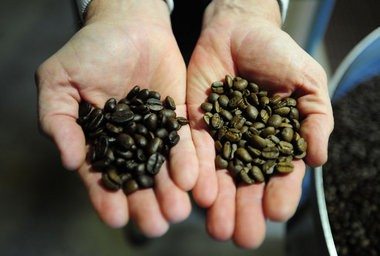You have probably never heard of coffee roasting, but this is a very common roasting technique in Spain, Portugal, France, Mexico and other South American countries. What is the difference between natural and torrefacto coffee? Which is more convenient: torrefacto or natural coffee? The answer is very clear to us (natural coffee always prevails) but, as there will certainly be more and fewer expert readers to clarify concepts and clear up any doubts, we are going to tackle the subject from the outset and cover all points of view.
We will see in detail what each type of coffee consists of separately, then we will explain the differences between the two, and finally, we will reason why one is more recommendable than the other.
What is Torrefacto Coffee: Definition
Torrefacto coffee beans (also known as torrado coffee in some parts of the world) are a variety of coffee obtained after subjecting the bean to a special process during roasting.
To obtain torrefacto coffee, the bean is roasted by adding a certain amount of sugar (no more than 15% of the total). During roasting, the coffee beans reach temperatures of up to 200°C, and this causes the sugar to caramelise and stick to the coffee beans, which then take on a different colour.
The torrefacto coffee has a shiny black layer (resulting from the burned sugar) that barely shows the coffee beans.

In this photo, we see the torrefacto coffee on the left (darker) and the natural roasted coffee (lighter) on the right.
Originally it was thought that in this way, the caramelised sugar would act as a kind of coating, which would allow the natural aromas, flavours and nuances of the coffee to be better preserved. The torrefacto roasting technique was widely used in times of scarce resources. By adding sugar to the roast, up to 15% more products could be obtained with the same amount of coffee beans (expensive raw material). It was even mixed with other components, such as cereals or chicory. So we can say that the origin of roasted coffee was purely economic.
Be that as it may, both of these reasons are now obsolete, and torrefacto coffee continues to exist only by tradition (and because derived from this tradition, it continues to be in demand among a certain sector of consumers), with no other objective argument to back it up.

Interestingly, this roasting technique is only used in certain regions of Central and South America and some European countries. In the rest of the world, Portuguese torrefacto coffee (or any other origin) is unknown.
Torrefacto coffee, although it is still on the market, is often consumed mixed in different proportions with naturally roasted coffee. It isn’t easy to find regions where 100% torrefacto roasted coffee is consumed without blending with anything. Forbidden roast process? So far, this has not been the case, although more than one consumer (whether seriously or as a joke) is arguing that torrefacto coffee should be banned by law. In short, opinions as always for all tastes.
Torrefacto Roasting Machine
If you are curious about how torrefacto coffee is roasted (or have never seen how a coffee roaster works), then you will find this video very interesting:
What is Natural Coffee
As opposed to torrefacto, natural roasted ground coffee is obtained without adding any element (neither sugar nor any other component) to the roasting process. It is why it is also known as natural roast coffee. By the way, remember that you can buy this and other types of roasted coffee in our huge store to buy coffee beans.
Differences between Natural and Torrefacto Coffee
Which is better: natural or torrefacto coffee? Without a doubt, natural-roasted coffee is a better product. But in this article, we will give some arguments to prove it.
- The torrefacto coffee, apart from being 15% darker in colour than the natural coffee, is also more bitter. This does not mean that it is heavier or more intense than natural roast coffee. It is simply due to the effect of the sugar.
- The roasted sugar, far from acting as a preservative, has its flavour and in the end, what it does is only mask the true flavours and aromas of the original coffee.
- Natural coffee does not have any kind of additives.
- Naturally, its sugar content makes it unsuitable for diabetics, and many consumers are unaware of the roasting process and add a lot of sugar to torrefacto coffee!
- Torrefacto coffee produces more cream than natural coffee, but it is an artificial cream – a product of the different components of the bean – which is not synonymous with quality.
So, if you are wondering which is healthier, natural coffee or torrefacto, you already know all the elements of judgement to answer, don’t you?
Which coffee is better: natural or blended?
The answer, in this case, is the same as in the previous one. Blended coffee is, as its name suggests, a mixture of natural roast coffee and torrefacto coffee, generally 50%, although this percentage can vary. In any case, a 100% natural coffee will always be better, without any presence of torrefacto.
Which coffee has more caffeine: Natural or Torrefacto?
Torrefacto coffee has more caffeine than natural coffee. And the answer is simple:
The caffeine in each coffee does not depend so much on the roasting method but on the origin of the beans. In this case, roast coffee is usually made from robusta beans, which have much more caffeine than arabica beans. Arabica beans are used more often for naturally roasted coffees.
You can find out more about this here: How much caffeine does decaffeinated coffee have?
And what do you prefer? Natural coffee or torrefacto coffee? And finally, if you drink torrefacto coffee, what proportion do you use in the blend?
